Rose of Sharon Hibiscus syriacus 'Melwhite'
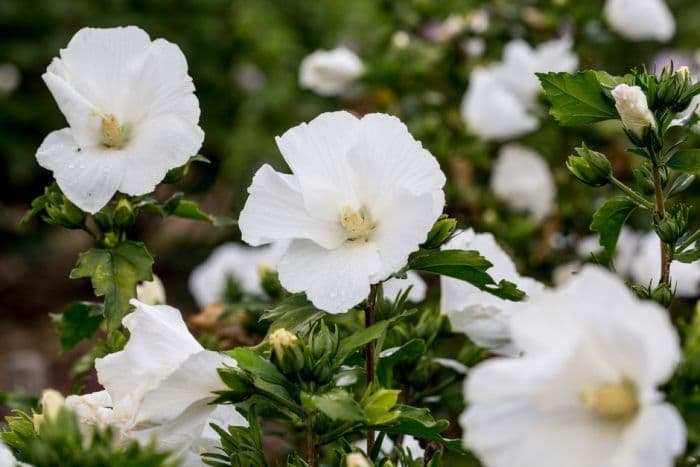
ABOUT
The Hibiscus syriacus 'Melwhite', commonly known as Rose of Sharon 'Freedom', presents itself with a lush display of creamy white flowers that possess a gentle, pleasing texture. Each blossom showcases a prominent and distinctive red heart at its center, which dramatically contrasts the paler petals. The blooms are sizeable and have a layered, somewhat ruffled appearance that adds to the plant's ornamental value. The leaves of Rose of Sharon 'Freedom' wear a bright green hue and have a slightly glossy surface with a toothed edge, which creates a lovely backdrop for the flowers. This plant tends to bloom profusely during the warmer months, with the flowering period extending from late summer into early fall, bringing a prolonged period of visual interest to any garden. The overall form of the Rose of Sharon 'Freedom' is upright and bushy, making it a favorite among gardeners looking to add a touch of elegance to their landscapes.
About this plant
 Names
NamesFamily
Malvaceae
Synonyms
Rose of Sharon, Shrub Althea, Korean Rose, Rose Mallow, Syrian Ketmia
Common names
Hibiscus syriacus 'Melwhite'
 Toxicity
ToxicityTo humans
Rose of Sharon is generally considered to be non-toxic to humans. There are no commonly reported symptoms of poisoning from ingesting parts of the Rose of Sharon, such as leaves, flowers, or bark. Nonetheless, consuming any non-food plant can potentially cause gastrointestinal discomfort or an allergic reaction in some individuals. It is always best to avoid ingesting plants that are not specifically grown for consumption.
To pets
For pets, the Rose of Sharon can be potentially toxic. While not considered highly poisonous, ingestion of its flowers, leaves, or other parts can cause gastrointestinal upset in cats, dogs, and other animals. Symptoms of toxicity in pets may include vomiting, diarrhea, nausea, and loss of appetite. If a pet consumes a large amount of the plant, it is advisable to contact a veterinarian.
 Characteristics
CharacteristicsLife cycle
Perennials
Foliage type
Deciduous
Color of leaves
Green
Flower color
White
Height
8-12 feet (2.4-3.7 meters)
Spread
6-10 feet (1.8-3 meters)
Plant type
Shrub
Hardiness zones
5-8
Native area
Asia
Benefits
 General Benefits
General Benefits- Ornamental Value: Known as Rose of Sharon, Hibiscus syriacus 'Melwhite' offers aesthetic appeal with its stunning white flowers, enhancing garden beauty and curb appeal.
- Wildlife Attraction: Its blossoms attract bees, butterflies, and other beneficial pollinators, which is essential for the health of any garden ecosystem.
- Drought Tolerance: Once established, this plant is quite hardy and can withstand periods of drought, making it suitable for gardens in drier climates.
- Low Maintenance: Rose of Sharon requires minimal care once settled, which is ideal for gardeners looking for plants that do not demand extensive upkeep.
- Long Blooming Period: It has a prolonged flowering season from summer through fall, providing continuous color and interest throughout these months.
- Versatility in Landscaping: It can be used as a hedge, screen, or focal point in landscape design, offering multiple uses in a garden setting.
 Medical Properties
Medical Properties- Anti-inflammatory: Hibiscus syriacus, also known as Rose of Sharon, may exhibit anti-inflammatory properties useful in reducing swelling.
- Analgesic: There is some indication that the plant has pain-relieving properties that could be beneficial in alleviating discomfort.
- Antipyretic: The plant might have a use in reducing fever due to its potential to lower body temperature.
- Emmenagogue: Hibiscus syriacus has been suggested to stimulate blood flow in the pelvic area and uterus, possibly aiding in menstruation.
- Diuretic: It may promote the increased passing of urine, helping in the reduction of fluid retention.
 Air-purifying Qualities
Air-purifying QualitiesThis plant is not specifically known for air purifying qualities.
 Other Uses
Other Uses- Hair Care Products: Hibiscus syriacus 'Melwhite', commonly known as Rose of Sharon, can be used in shampoos and conditioners due to its emollient properties which help to soothe the scalp and condition hair.
- Natural Dye: The flowers of the plant can be used to create a natural dye for fabrics, yielding a delicate mauve or pink hue.
- Edible Garnish: The flowers are edible and can add a unique and attractive touch to salads, desserts, or as plate garnishes in gourmet cuisine.
- Culinary Extracts: Blossoms can be steeped in alcohol to make floral extracts that can be used in flavoring baked goods, cocktails, or syrups.
- Paper Making: The fibrous material from stems and bark can be used in the handmade paper manufacturing process, often for artisanal crafts and artistry.
- Landscape Design: Due to its compact shape and ornamental value, it's often employed as a living fence or privacy screen in landscape design.
- Ink Production: The pigment from the flowers can be used to produce natural inks for art or calligraphy.
- Religious Ceremonies: In some cultures, its flowers might be used for adornment or as an offering in religious ceremonies due to their symbolization of purity.
- Companion Planting: It may be used in gardens to help attract pollinators like bees and butterflies, thus supporting the health of the entire garden ecosystem.
- Photography: As an ornamental plant with distinctive blooms, Rose of Sharon is a favorite subject for photographers and can be used in commercial photography to add natural beauty.
Interesting Facts
 Feng Shui
Feng ShuiThe Hibiscus is not used in Feng Shui practice.
 Zodiac Sign Compitability
Zodiac Sign CompitabilityThe Hibiscus is not used in astrology practice.
 Plant Symbolism
Plant Symbolism- Beauty: The hibiscus flower, with its large, colorful petals, is commonly associated with beauty and femininity.
- Purity: In South Korea, where Hibiscus syriacus is the national flower (known as mugunghwa), it represents purity and enduring spirit.
- Love: In various cultures, the hibiscus can symbolize a perfect wife or woman, making it a common symbol in weddings and related celebrations.
- Warmth and Hospitality: As a common gesture of welcome in the Hawaiian culture, the hibiscus, though not specifically the variety 'Melwhite', may be a symbol of hospitality.
- Delicate Beauty: Despite its showy appearance, the hibiscus flower is fragile and short-lived, often symbolizing delicate beauty or the fleeting nature of fame or personal glory.
 Water
WaterThe Rose of Sharon requires consistent moisture, especially during hot and dry periods. During the growing season, water deeply once a week, providing about 1 to 1.5 gallons of water per session. Ensure the soil is well-draining but remains moist, as the plant does not tolerate waterlogged conditions. Reduce watering in the fall and winter when the plant is dormant. It is best to water the plant early in the morning or late in the afternoon to prevent rapid evaporation and to allow the water to penetrate deeper into the soil.
 Light
LightRose of Sharon thrives in full sun to partial shade. It prefers at least six hours of direct sunlight daily to perform its best. Planting in a location that receives morning sun and afternoon shade can help protect the blooms from intense heat, although this shrub is quite tolerant of hot summer weather.
 Temperature
TemperatureRose of Sharon is hardy and can withstand temperatures as low as -20°F and as high as 100°F. However, the ideal growing conditions for this plant are between 60°F and 85°F. It is capable of surviving in zones 5 through 8 and requires a period of cold dormancy to bloom effectively.
 Pruning
PruningThe Rose of Sharon benefits from pruning to maintain its shape, remove dead wood, and encourage more vigorous blooming. Pruning should be done in late winter or early spring before new growth starts. Thin out overcrowded branches and cut back any old wood to about 2-3 buds to promote the growth of new flowering shoots. The plant can also be pruned for size control or to create a more appealing shape according to the gardener's preference.
 Cleaning
CleaningAs needed
 Soil
SoilThe Rose of Sharon prefers well-draining, loamy soil enriched with organic matter. The ideal soil pH for this plant is slightly acidic to slightly alkaline, ranging from 5.5 to 7.5. A mix of two parts loam, one part peat moss, and one part perlite or sand can create an excellent soil environment for Hibiscus syriacus 'Melwhite'.
 Repotting
RepottingRose of Sharon is usually planted outdoors and does not require frequent repotting. If grown in containers, it should be repotted every 2-3 years or when it becomes root bound.
 Humidity & Misting
Humidity & MistingRose of Sharon thrives in moderate humidity conditions typical of outdoor environments. Excessive humidity is not required; ambient outdoor humidity levels are generally sufficient.
 Suitable locations
Suitable locationsIndoor
Place in bright, indirect light and ensure enough space for growth.
Outdoor
Plant in full sun to partial shade in well-draining soil.
Hardiness zone
5-8 USDA
 Life cycle
Life cycleHibiscus syriacus 'Melwhite', commonly known as the Rose of Sharon, begins its life as a dormant seed which requires a period of cold stratification to germinate effectively. After stratification, the seeds sprout in spring, developing into small seedlings with characteristic foliage. As the seedlings mature, they grow into bushy shrubs, reaching flowering maturity typically within 2-3 years, displaying large, white, trumpet-shaped blooms with a prominent red center throughout the summer and into early fall. Following pollination, often by bees, butterflies, and other insects, the flowers develop into dry seed capsules by late fall, dispersing seeds that contribute to the spread of the plant. Throughout its life, the Rose of Sharon experiences a period of dormancy in the winter, losing its leaves and entering a state of rest until the warmth of spring spurs new growth. This cycle repeats annually, with the shrub having a lifespan that can span several decades if provided with suitable growing conditions.
 Propogation
PropogationPropogation time
Summer to Early Fall
Propogation: The Hibiscus syriacus 'Melwhite', commonly known as the Rose of Sharon, is typically propagated through softwood cuttings. This method is popular due to its simplicity and effectiveness. To propagate using softwood cuttings, select a healthy, non-flowering stem in late spring or early summer when new growth is still green and flexible. Cut a 4 to 6-inch (10 to 15 cm) section of stem, making the cut just below a leaf node. Remove the leaves from the lower half of the cutting and dip the cut end into a rooting hormone powder or gel. Afterward, plant the cutting in a pot filled with a mix of potting soil and perlite or sand to ensure good drainage. Keep the soil moist and the cutting in a warm, indirect light until it develops roots, which typically takes a few weeks.
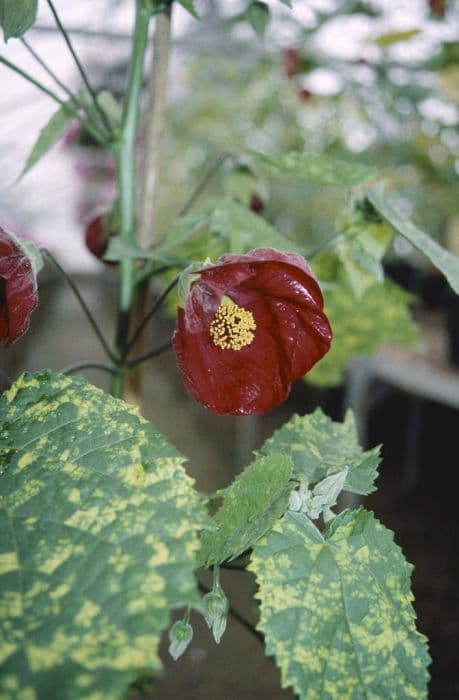
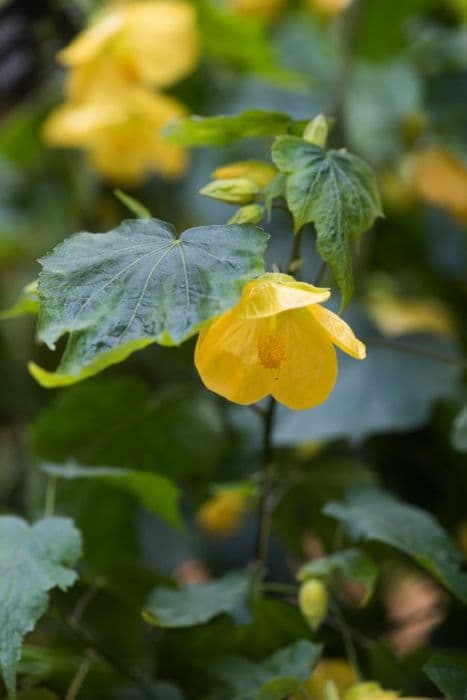
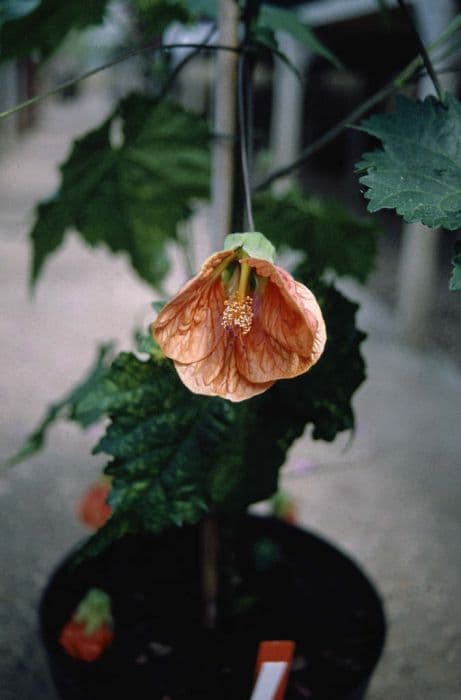
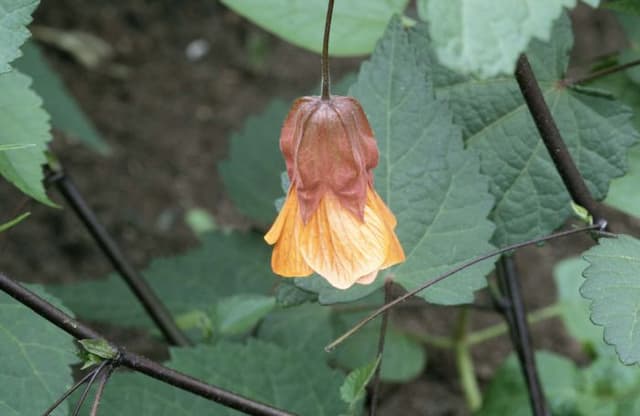

![Abutilon [Yellow Trumpet]](/_next/image?url=https%3A%2F%2Fplants-admin.emdemapps.com%2Fimages%2Fplants%2F%2Fimages%2F604b5caa8b4fb.png&w=640&q=75)


